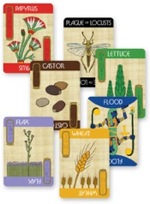
|
About OgreCave and its staff
|

|
by Demian Katz
This game is featured in the OgreCave Christmas Gift Guide 2010. Though its theme ostensibly involves growing crops in Egypt, Nile is actually an abstract strategy game that should hold the interest of traditional card game fans whether they care about ancient agriculture or not. The rules are fairly straightforward, though there are two key twists that help make the game challenging and competitive. The first twist is that there are only five crops, yet no two players may grow the same crop at the same time. One player's field can be wiped out if an opponent plants a larger field of the same crop. The second twist is that during scoring at the end of the game, the winner is the player who has the most cards in their least numerous stockpiled commodity. This means that you need to focus on harvesting a balanced set of crops, since big pay-offs in one crop are worthless if you fail to diversify in the others. A player with only one card in each of the five crops will beat a player with dozens of cards distributed between only four of the five crops.
The length of the game varies depending on the number of players – for each participant, the entire deck is reshuffled once, so for example, in a four-player game, you play through the deck four times. To add an element of unpredictability to the proceedings, the deck contains a "plague of locusts" card which, when drawn, wipes out the largest field (or fields, in case of a tie). The plague helps you keep track of how many reshuffles remain before the end of the game, since it's usually not too hard to remember how many times it has appeared! The biggest complaint I can level at the game is that I'm unhappy with the physical quality of the cards; although they look good and have a nice surface texture, they're a little too thick, which makes them hard to shuffle and seems to contribute to fast wear – I noticed small tears appearing on the sides after only a couple of plays. I'm sure the game will survive well enough to remain playable for quite some time, but it already looks a little rough. Given that I expect to be pulling this out periodically, I wish it were a bit sturdier! Still, I'd rather have a good game that looks well-loved than an indestructible game that I don't actually want to play!
Conclusions Links:
|
||||
 Nile: The Game of Ancient Agriculture (2010)
Nile: The Game of Ancient Agriculture (2010) During the course of the game, each player's turn follows a few standard
steps. First, the top card of the draw deck is turned over to determine
the one or two crop types that flood this turn. Players with flooded
crops automatically harvest the top planted cards from these crops and
stockpile them for later. Flooding is also important because the
flooded crop type(s) cannot be planted on the current turn. Next comes
trading, where a pair of cards from the hand or stockpile may be cashed
in for one of two possible effects: to draw a single replacement card,
or to repeat the flood phase with a new card. After this comes card
play, during which crops may be planted to new or existing fields, or
"speculation cards" may be played to bet on the outcome of the next
flood, with extra cards being awarded for successful predictions.
Finally, the turn ends with the drawing of two cards to restock the
hand.
During the course of the game, each player's turn follows a few standard
steps. First, the top card of the draw deck is turned over to determine
the one or two crop types that flood this turn. Players with flooded
crops automatically harvest the top planted cards from these crops and
stockpile them for later. Flooding is also important because the
flooded crop type(s) cannot be planted on the current turn. Next comes
trading, where a pair of cards from the hand or stockpile may be cashed
in for one of two possible effects: to draw a single replacement card,
or to repeat the flood phase with a new card. After this comes card
play, during which crops may be planted to new or existing fields, or
"speculation cards" may be played to bet on the outcome of the next
flood, with extra cards being awarded for successful predictions.
Finally, the turn ends with the drawing of two cards to restock the
hand.